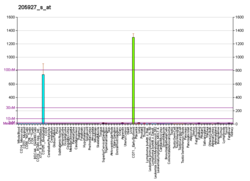Cathepsin E
| CTSE | |||||||||||||||||
|---|---|---|---|---|---|---|---|---|---|---|---|---|---|---|---|---|---|
 |
|||||||||||||||||
|
|||||||||||||||||
| Identifiers | |||||||||||||||||
| Aliases | CTSE, Ctse, A430072O03Rik, C920004C08Rik, CE, CatE, cathepsin E | ||||||||||||||||
| External IDs | MGI: 107361 HomoloGene: 37551 GeneCards: CTSE | ||||||||||||||||
|
|||||||||||||||||
| RNA expression pattern | |||||||||||||||||
 |
|||||||||||||||||
| More reference expression data | |||||||||||||||||
| Orthologs | |||||||||||||||||
| Species | Human | Mouse | |||||||||||||||
| Entrez |
|
|
|||||||||||||||
| Ensembl |
|
|
|||||||||||||||
| UniProt |
|
|
|||||||||||||||
| RefSeq (mRNA) |
|
|
|||||||||||||||
| RefSeq (protein) |
|
|
|||||||||||||||
| Location (UCSC) | Chr 1: 206.01 – 206.02 Mb | Chr 1: 131.64 – 131.68 Mb | |||||||||||||||
| PubMed search | |||||||||||||||||
NM_001910
NM_148964
NM_001317331
NP_001304260
NP_001901
NP_683865
Cathepsin E is an enzyme that in humans is encoded by the CTSE gene.
Cathepsin E is a protease found in animals, as well as various other organisms, that belongs to the aspartic protease group. In humans it is encoded by the CTSE gene located at 1q32 on chromosome 1. It is an intracellular non-lysosomal glycoprotein that is mainly found in the skin and in immune cells. The protein is an aspartyl protease that functions as a disulfide-linked homodimer, and has an oligosaccharide chain of the high-mannose type. It is a member of the peptidase A1 family, and therefore observes specificity similar to that of Pepsin A and Cathepsin D. Cathepsin E is an intracellular enzyme and does not appear to be involved in dietary protein digestion. It is found at highest abundance on the stomach’s epithelial mucus producing cell surfaces. It is the first aspartic protease present in the fetal stomach and is found in more than half of gastric cancers, leading to it appearing to be an oncofetal antigen. Transcript variants utilizing alternative polyadenylation signals and two transcript variants encoding different isoforms exist for this gene.
...
Wikipedia
